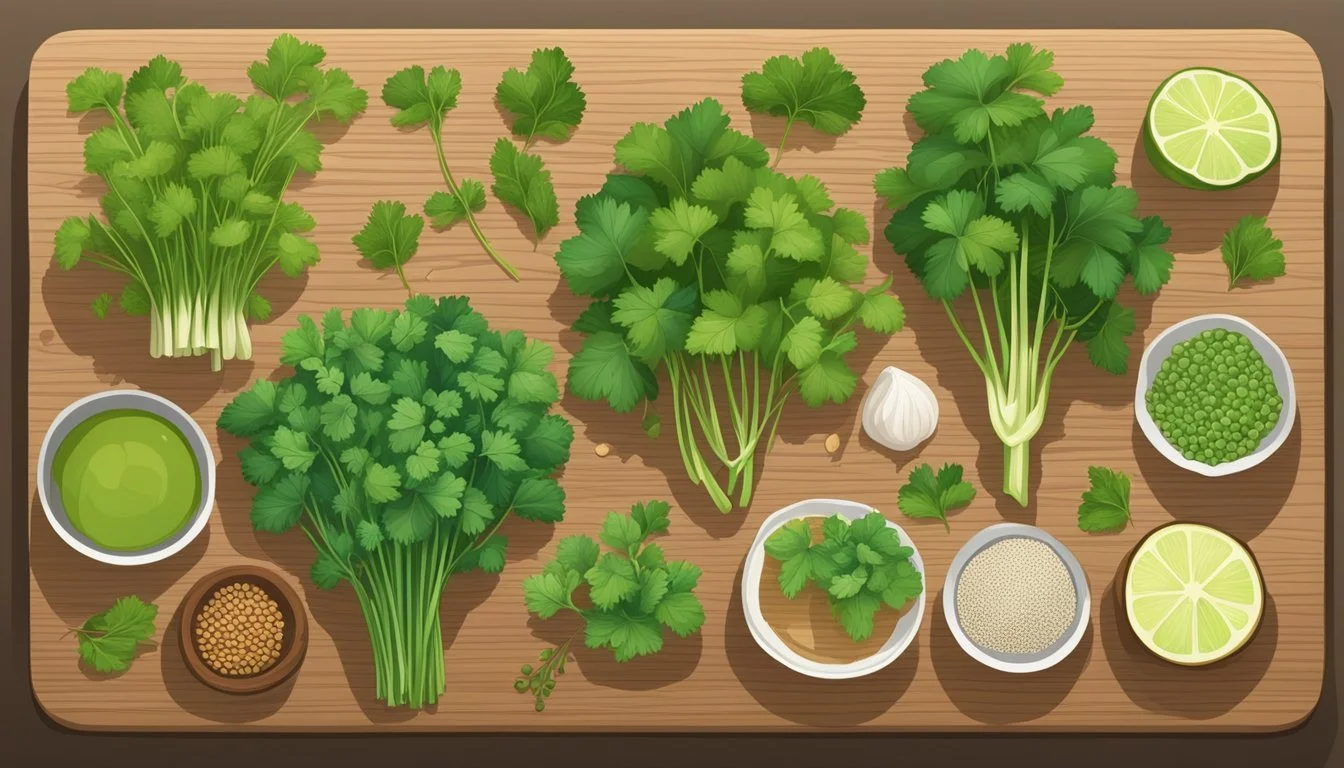Cilantro Roots Substitutes
Top Alternatives for Every Recipe
Cilantro, with its fresh and citrusy profile, is a beloved herb in many kitchens, but when it comes to its roots, many cooks find themselves at a loss for substitutes. If you're looking for alternatives to cilantro roots, there are several excellent options available that can provide similar flavors and aromas.
Coriander seeds, for instance, are a commonly used substitute. These seeds are the dried version of the cilantro plant and offer a slightly different, but complementary flavor. Another suitable alternative is the use of coriander stems, which can closely replicate the herbaceous quality of cilantro roots in various dishes.
For those who prefer a more distinct and aromatic twist, cumin seeds can also serve in a pinch. They bring a nutty and earthy flavor profile that works well in hearty recipes like soups and stews. The choice of substitute often depends on personal preference and the particular dish you're preparing.
Understanding Cilantro
Cilantro, also known as coriander, is widely used in culinary applications and offers numerous health benefits. Its botanical background and versatility make it a staple in various cuisines.
Botanical Background
Cilantro (Coriandrum sativum) is a member of the Apiaceae family. It has delicate, feathery leaves, and its seeds are known as coriander. Native to regions spanning from Southern Europe to Northern Africa and Southwestern Asia, it thrives in temperate climates. The plant can grow up to 50 cm tall and produces small, white or pink flowers. Both the leaves and seeds are edible, though they impart different flavors. The roots are also used in some culinary traditions, particularly in Southeast Asian cuisine.
Cilantro in Culinary Uses
Cilantro is prized for its fresh, citrusy flavor. Its leaves, often used as a garnish, add a bright note to dishes like salsas, guacamole, and soups. In Thai and Vietnamese cuisine, cilantro is integral to various salads, soups, and garnishes. The seeds, known as coriander, ground or whole, lend a warm, nutty flavor to dishes and spice blends like garam masala. Cilantro roots, less common but equally flavorful, are used in Thai curry pastes and marinades to add a deeper herbaceous note.
Health Benefits
Cilantro is packed with antioxidants known to combat oxidative stress. It contains vitamins A, C, and K, contributing to overall wellness. The herb is also recognized for its potential to aid digestion; its natural oils may enhance the production of digestive enzymes and juices. Some studies suggest that cilantro has antimicrobial properties, which can help combat certain infections. Additionally, it has been noted for its potential in lowering blood sugar and cholesterol levels, making it a beneficial component of a balanced diet.
Cilantro, whether used for its leaves, seeds, or roots, remains a versatile and nutritious ingredient in cooking.
The Need for Substitutes
Individuals may need to find substitutes for cilantro roots due to personal taste preferences or issues with ingredient availability.
Taste Preferences
Cilantro often presents a polarizing flavor profile. For many, its bright, peppery taste with hints of lemon is delightful, while others find it unpleasantly soapy. This distinct taste can heavily influence a dish.
Given this divisive nature, those who dislike cilantro roots need alternatives that provide similar freshness and earthiness without the undesirable soapy flavor.
Alternatives like parsley or celery root can mimic parts of cilantro's profile, making them suitable substitutes for those seeking a more agreeable taste.
Availability Challenges
In some regions, fresh cilantro roots can be challenging to find. This lack of availability necessitates substitutions to ensure culinary success.
Seasonal variations and supply chain issues may also contribute to their scarcity. Chefs and home cooks often turn to alternatives like coriander seeds or carrot tops, which can provide desired flavors when cilantro roots are not an option.
These substitutes maintain the integrity of the dish while allowing for flexibility in sourcing.
Overall, these substitutions are essential for overcoming both taste and availability challenges, ensuring that recipes remain flavorful and accessible to all.
Popular Cilantro Alternatives
When cilantro roots are unavailable, there are various substitutes that can replicate its unique flavors. These alternatives range from other herbs with similar citrusy or peppery notes to unique regional herbs that offer comparable tastes.
Parsley and Its Varieties
Italian parsley or flat-leaf parsley serves as a common substitute for cilantro. Its fresh, slightly peppery flavor can mimic cilantro in salads, salsas, and garnishes.
Flat-leaf parsley is often preferred for its more robust flavor compared to curly parsley. It’s suitable for recipes where a fresh cilantro taste is needed without overwhelming the dish with a strong herbaceous note.
Fresh and Dried Basil
Thai basil offers a unique, anise-like flavor that can replace cilantro in many Asian dishes. Its aromatic properties blend well with various seasonings, making it a versatile herb.
Dried basil can also stand in for dried cilantro. However, due to its concentrated flavor, it should be used sparingly to avoid overpowering the dish. Basil maintains the fresh, herbaceous qualities that many recipes demand.
Herbs With Citrusy Notes
For those seeking a citrusy flavor, fresh mint and celery leaves provide excellent alternatives. Mint brings a refreshing, bold taste, making it suitable for Middle Eastern and Asian cuisines.
Celery leaves add a subtle citrus note, enhanced when used fresh in salads and salsas. These herbs help replicate the bright, zesty flavor typically provided by cilantro.
Herbs With Peppery Flavors
Rau ram or Vietnamese cilantro has a similar peppery taste, making it a near-perfect substitute in Southeast Asian recipes. Its aromatic flavor profile is slightly more intense than cilantro.
Culantro also brings a bold, peppery flavor, often used in Caribbean and Latin American dishes. It is best used fresh and can handle the cooking process better than regular cilantro.
Unique Regional Herbs
Papalo is a versatile plant mainly found in South America. Its unique flavor is robust and somewhat similar to cilantro, making it an excellent substitute in traditional Mexican dishes.
Both fresh and dried forms of these herbs can replicate the nuances of cilantro, depending on culinary requirements. They add depth and authenticity, particularly in regional recipes where cilantro plays a crucial role.
Combining Herbs and Spices as Substitutes
For an effective substitute for cilantro roots, combining various herbs and spices can create a complex and harmonized flavor profile. By understanding how distinct ingredients interact, specific cuisine blends can be crafted, and versatile homemade mixes can be prepared. This approach ensures a balanced taste suitable for diverse dishes.
Creating a Flavor Profile
Combining different herbs and spices can replicate the unique flavors of cilantro roots. Coriander seeds and cumin can form a base, offering an earthy undertone. Adding a touch of lime juice or lemon juice introduces the citrusy freshness cilantro is known for.
Pairing caraway seeds with garam masala can also add depth. Each ingredient brings forward its characteristics, making it essential to adjust quantities to achieve the desired balance.
Specific Cuisine Blends
Certain cuisine blends work exceptionally well as substitutes for cilantro roots. For Thai dishes, combining Thai basil with coriander seeds and a splash of lime juice can mimic the original flavor. In Indian cuisine, a mix of coriander seeds, cumin, and curry powder serves as a robust base.
Greek and Middle Eastern recipes can benefit from mixtures including parsley, lemon juice, and caraway seeds. Understanding regional flavor profiles helps in selecting the right combination for each dish.
Homemade Mixes for Versatility
Creating homemade spice blends offers versatility and control over flavor intensity. A basic mix could include coriander seeds, cumin, and a bit of lemon juice. Adding garam masala enhances complexity, suitable for both vegetarian and meat dishes.
For a zesty variant, incorporate lime juice with caraway seeds and a touch of papalo. Store these mixes in airtight containers to maintain freshness. Adjusting each mix according to the dish—like increasing lemon juice for tangy freshness or using more cumin for earthiness—ensures the substitute aligns perfectly with the intended recipe.
Considerations When Choosing Substitutes
Selecting the right substitute for cilantro roots involves matching the flavor intensity to the dish, understanding the dish's culinary origin, and considering the different components of the recipe.
Matching Flavor Intensity
Cilantro roots have a robust, earthy flavor that can be challenging to replicate. When seeking substitutes, fresh cilantro leaves or parsley roots can often suffice due to their somewhat similar flavors, though they are milder.
Another potential substitute is Vietnamese cilantro (Rau Ram), noted for its peppery and aromatic taste. Celery roots can also offer a mild, earthy flavor but won’t deliver the exact same strength. Adjust quantities carefully to maintain flavor balance.
Understanding the Dish's Origin
Cilantro roots are commonly used in Asian, Latin American, and Caribbean cuisines. Recognizing the dish’s origin can provide insights into suitable substitutes.
For Asian recipes, lemongrass or Thai basil might work well as alternatives, enhancing the dish with complementary flavors. In Latin American and Caribbean dishes, coriander seeds or culantro (recao) can serve as appropriate substitutes, particularly when trying to maintain authenticity.
Considering the Recipe's Components
When choosing a substitute, it’s critical to consider how cilantro roots interact with other ingredients in a recipe. In dishes where the roots are blended into a paste or used as a base, Italian parsley roots or ginger roots might be suitable.
If the cilantro roots are meant to infuse broths or soups, daikon radish or mustard greens can be effective. Assessing the recipe's overall complexity and ingredient harmony will help ensure the substitute maintains the intended flavor profile.
Non-Herbal Cilantro Substitutes
Substituting cilantro roots with non-herbal alternatives can be done using ingredients with similar flavors and profiles. These include certain citrus juices and specific spices and seeds.
Citrus Juices as Enhancers
Lemon and lime juices are excellent for replacing the fresh and tangy aspect of cilantro roots. The citrusy flavor they impart can brighten up dishes. It is best to use fresh juice for the most pronounced effect.
Lemon juice adds a zesty and slightly sweet taste.
Lime juice, on the other hand, offers a sharper citrus profile.
These juices are particularly effective in salsa, marinades, and salads. Lemon juice works well in poultry and seafood dishes, while lime juice is preferred in Mexican and Thai cuisines.
Seeds and Spices for Depth
Ground coriander is a common substitute when looking to mimic the earthy tones of cilantro roots. It provides a mild, slightly sweet, and citrusy flavor. Cumin seeds and coriander seeds can also add depth to the dish.
Cumin seeds lend a warm and nutty flavor, useful in stews and curries.
Coriander seeds provide a gentle citrus note.
Fennel seeds offer a sweet and licorice-like taste and can be ground up or used whole. Other dried herbs like oregano, dill, and parsley bring an aromatic quality that enriches the overall flavor. Dried oregano is especially potent, so use it sparingly.
Using Cilantro Substitutes in Different Cuisines
Selecting the right substitute for cilantro depends largely on the specific cuisine and flavor profile of the dish. Different culinary traditions can be paired with herbs that match or enhance their unique tastes.
Asian Flavor Adaptations
Asian cuisine often relies on the fresh, vibrant notes of cilantro. Suitable alternatives include fresh Thai basil, which brings a slightly sweet and peppery kick, making it an excellent replacement in dishes like pho or spring rolls.
Tarragon and fresh dill weed also work well, especially in Southeast Asian dishes like Vietnamese noodle salads or Thai curries. These substitutes maintain the dish’s aromatic signature, blending seamlessly with spices and ingredients characteristic of Asian cooking.
Latin and Caribbean Variations
In Latin American and Caribbean dishes, cilantro’s bright, citrusy flavor is pivotal. Oregano is a substitute that fits well, especially in salsas and marinades, where it adds a robust, earthy scent.
For a more peppery note, Vietnamese cilantro (rau ram) is a suitable alternative. This herb mirrors cilantro’s taste profile closely and can be used in dishes like ceviche or tacos. Dill also works here, imparting a subtle, fresh flavor to Caribbean soups and stews.
Mediterranean and European Influences
In Mediterranean and European cuisines, cilantro is less common, but when needed, herbs like flat-leaf parsley provide a fresh, mild flavor perfect for tabbouleh or pasta dishes. Tarragon brings a nuanced, licorice-like taste, suitable for French or Italian dishes.
Fresh dill weed serves well in dishes like Greek salads or Scandinavian fish recipes. Its crisp taste ensures the dish retains its light, refreshing qualities without overpowering the other ingredients.
Cilantro's Role in Color and Presentation
Cilantro is known for its vibrant green color and versatile use in enhancing the visual appeal of dishes. Whether used as a garnish or mixed into recipes, it adds both texture and aesthetic value.
Visual Appeal of Cilantro and Its Substitutes
Cilantro, with its bright green leaves, imparts a fresh and lively appearance to dishes. This attractive hue makes it an ideal garnish for a variety of cuisines, from Mexican tacos to Asian soups. The fresh leaves of cilantro create a striking contrast against other ingredients, making meals look more appetizing and colorful.
Substitutes like culantro, papalo, and rau ram also offer similar vibrant green hues. While culantro has broader leaves, rau ram closely mimics the slender leaves of cilantro. Papalo, though slightly different in leaf shape, still provides the necessary green pop. These substitutes maintain the dish's visual appeal, ensuring the presentation remains visually appealing and fresh.
Texture Considerations
The texture of fresh cilantro adds a delicate crispness. Its finely divided leaves blend seamlessly into salsas and salads. This herb's natural structure provides a light crunch without overpowering other ingredients.
Choosing substitutes with similar textures is crucial. Culantro offers a comparable experience, though its leaves are slightly tougher and broader. Rau ram is peppery but mimics cilantro's texture well. On the other hand, papalo, though a bit coarser, can still be used effectively when chopped finely. Ensuring the right texture helps maintain the mouthfeel and overall sensory experience of the original dish.
Growing Your Own Cilantro Alternatives
Cultivating alternative herbs to cilantro can be a rewarding venture, providing fresh leaves for your recipes and tailoring flavors to your personal preference. Below are essential tips and strategies for home gardening and maintaining herb freshness.
Home Gardening Tips
Growers can experiment with several cilantro substitutes such as dill, parsley, and Vietnamese cilantro (rau ram). Each herb requires different conditions:
Dill:
Light: Full sun
Water: Moderate; avoid overwatering
Soil: Well-drained, slightly acidic
Parsley:
Light: Moderate sunlight
Water: Regular watering; keep soil moist
Soil: Fertile, well-draining soil
Rau Ram:
Light: Partially shaded conditions
Water: Keep soil consistently moist
Soil: Rich, well-drained
Plant seeds directly into the soil or start indoors for better control of growing conditions. Maintain a steady temperature and provide adequate spacing to allow herbs to flourish. Keep an eye on pests and use organic treatments to maintain plant health.
Maintaining Herb Freshness
To preserve the flavor and potency of your herbs, proper harvesting and storage are crucial. Harvest cilantro alternatives by cutting the fresh leaves in the morning after the dew has dried but before the sun becomes too intense.
Fresh leaves: Store in plastic bags with a damp paper towel in the refrigerator.
Drying leaves: Air-dry in a cool, dark place, then store in airtight containers.
For optimal flavor, use fresh herbs within a week or dried herbs within six months. Regularly check for signs of spoilage like discoloration or mold. Store jars away from direct sunlight and heat to maintain potency. Properly handled, these homegrown herbs will provide the freshest ingredients for your culinary creations.







